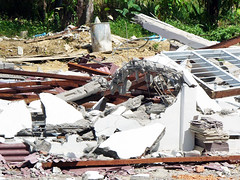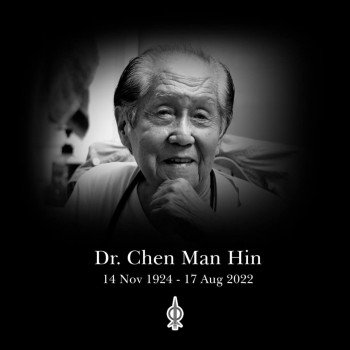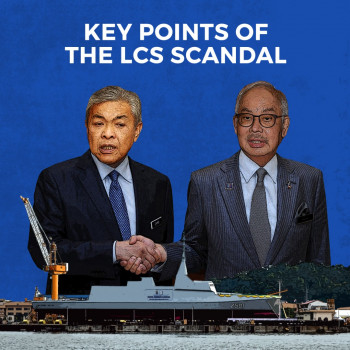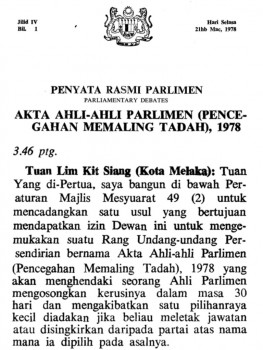After 53 years of independence, the Orang Asli or Orang Asal (OA) community of today are not much better off than their forebears. A 1999 study and statistics released by the Orang Asli Affairs Department (JHEOA) of the government shows that 81.4 percent of the OA population are living below the poverty line, compared with the nationwide figure of 8.5 percent. 
Their living condition is appallingly poor: 52.5 percent have no piped water, 51.8 percent are without electricity and 43.7 percent have no toilet facilities in their homes. A visit to any OA settlement in the rural areas today will show that things have not improved much since then.
Additionally, with a 49.2 percent illiteracy rate and with only 38.5 percent having a primary school education, the highest amongst the major races, the OAs is at a big disadvantage when competing for better paying jobs with other races.
In an ecology and nutrition intake study of OAs by two Universiti Putra Malaysia researchers in 2007, they noted that the low levels of nutrition amongst the OAs were due to their poverty levels. With many OAs engaged in low paying jobs requiring physical and manual labour, their poverty becomes a vicious cycle that affects their well being. With lower incomes, it means less nutritious food for the family. As a result, some are malnourished and suffer physically.
In addition to the low paying jobs predicament, they have to contend with the bigger-built migrant workers in fighting for jobs. With unstable low paying jobs and remote accessibility, many are still subsisting on foraging in the forests and fishing in rivers for food.
Discriminated reality
The OAs were the forgotten people at the Merdeka negotiation table. While the Malays were recognised as the race with special status, no such status was accorded to the OAs in the Federal Constitution. The most overt mention of OAs in the constitution is the Aboriginal Act 1954.
According to Dr Colin Nicholas from the Centre for Orang Asli Concerns (COAC), the Act gives the government the foil to treat the OAs as “wards of the state”, to be cared for paternalistically and assimilated into the mainstream society (i.e. a government instrument to control the OAs). Take for example the recognition of the aboriginal rights. It is solely at the discretion of the Rural Development Minister, while the director general (DG) of the JHEOA is in charge of the administration, welfare and advancement of OAs.
Their powers are pervasive; the DG is empowered to do “all acts reasonably necessary and incidental to or connected with the performance of his functions under the Act”. Furthermore, the DG can detain and remove any person he believes is “detrimental to the welfare of any aborigine”. In effect, it gives the JHEOA unfettered control over the lives of the OAs.
The funding for JHEOA’s priorities looked circumspect as well. For 2011, the budgeted funds for this department totalled RM110 million, of which RM35 million is used for staffs emoluments, with RM 74 million left for the direct benefit of the OA community. With the current population of the OA at around 150,000, that translates to a measly RM497 for each OA for the entire year.
Recently, news of the JHEOA’s neglect of the OAs’ healthcare was highlighted when Dr Selva Vathany Kanapathi Pillai of Gombak Hospital alleged that the country’s only dedicated OA hospital is treating more non-OAs than OAs, simply because it is more convenient for them to use the hospital than others (The Nut Graph, 22 March).
In land matters, their ownership rights are also being taken advantage of by the government. Dr Nicholas says the Aboriginal Act basically defined the OA dwellers as tenant-at-will of the government; i.e. they are living on the land at the pleasure of the government. In June 2010, the government has proposed to gazette 50,000 hectares (out of the currently estimated 126,000 hectares) of OA area and reserve land across Peninsular Malaysia as OA reserve, thus drastically reducing the total area which the OAs can used to grow crops and gather food.
In addition, the government has been embarking on a concerted effort to assimilate the OAs into the Malay community via state-sponsored Islamisation programs. This attempt to covertly absorb and wipe away the OA communal identity has been ongoing for years. A researcher, Nobuta Toshihiro, noted that the Religious Affairs Department and JHEOA were appointing and training some 250 Muslim missionaries in 1991 to Islamise the OAs. It is only with the help of some Internet news portal (e.g. the Nut Graph) in recent years, that such news has become public knowledge.
A secluded world
The pervasive control over the OAs stretches even into the area of information dissemination. The DG of JHEOA is empowered to bar entry into and remove any one from the OA reserve and area. With outsiders barred from campaigning in the OA areas, the OAs becomes a reliable vote bank of BN as they are often told that voting for BN means voting for the government.
Any outsiders attempting to help or propagate to them, especially those from non-Islamic religious organisations, will be intimidated and kept off the OA reserve and area. A Christian organisation involved in helping build a church in Kg Jias, Gua Musang for the OAs was harassed several times (Malaysiakini, 7 June 2007). The church was torn down in 2007 and another church in Pos Pasik in Gua Musang is awaiting a similar fate. In the case of Kg Jias, both the JHEOA and state government are equally guilty of denying the OA their religious rights, as shown by the court cases brought against them.
Indeed, the present OAs’ plight looks grim under this BN government. Perak and Selangor Pakatan Rakyat state governments have tried to help their state OAs with the land ownership issues. However, PR’s efforts in assisting the OA are restricted as the current administrative structure and legal statutes are weighted heavily in the federal government’s favour.
PR needs to come out with a new policy and blueprint in helping the OAs when it forms the next federal government. Clearly, the current structure of policies and administration are not helping the OAs at all. The OAs are awaiting a liberator. Is PR up to the task?



